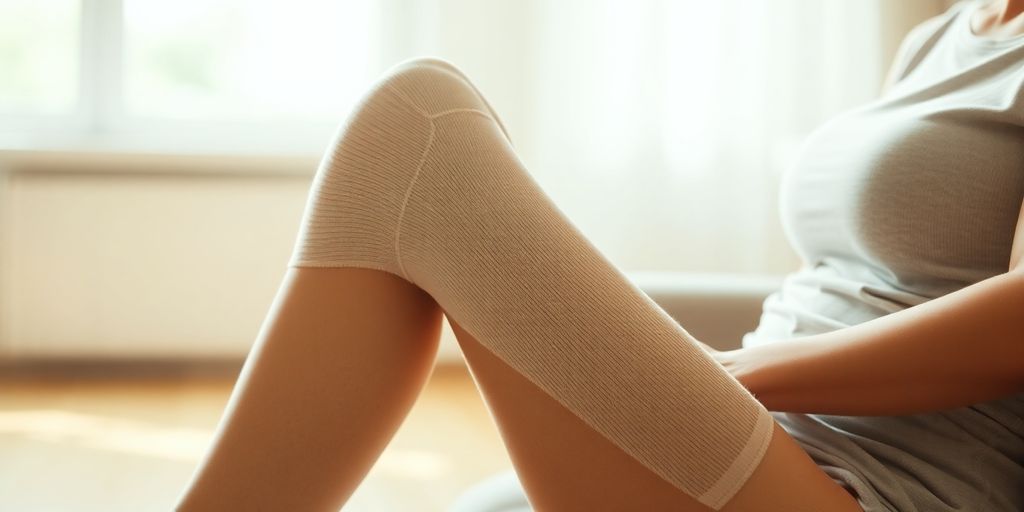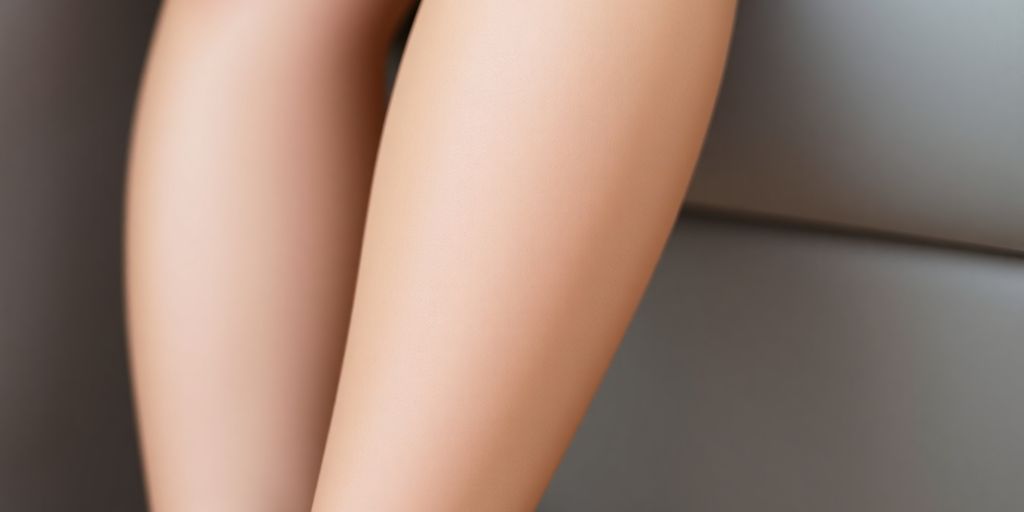Feeling that constant ache or heaviness in your legs? It might be more than just a long day. If you've been dealing with ongoing leg discomfort, swelling, or even visible veins, you could be experiencing chronic venous insufficiency. But don't worry, there's a simple, effective tool that can really make a difference: Chronic Venous Insufficiency Compression Socks. These aren't just regular socks; they're designed to help your legs feel better and improve your overall leg health. Let's dig into how these socks work and why they might be exactly what you need.
Key Takeaways
- Chronic Venous Insufficiency Compression Socks help blood flow better in your legs.
- They can make your legs feel less painful and swollen.
- Wearing these socks might stop varicose veins from getting worse.
- It's good to wear them most of the day, but listen to your body.
- Always talk to a doctor about the right compression level for you.
Understanding Chronic Venous Insufficiency
Defining The Condition
Chronic venous insufficiency (CVI) is a condition where the veins in your legs have trouble sending blood back up to your heart. Normally, veins have one-way valves that keep blood flowing in the right direction. With CVI, these valves become damaged or weakened. This causes blood to pool in the legs, leading to increased pressure and a range of uncomfortable symptoms. It's not usually life-threatening, but it can really impact your quality of life if left unmanaged. Think of it like a plumbing problem in your legs – the pipes aren't working as efficiently as they should.
Common Symptoms To Recognize
Recognizing the symptoms of CVI early can help you get the treatment you need to manage the condition effectively. Symptoms can vary from person to person, but some of the most common ones include:
- Aching or throbbing pain in the legs
- Swelling, especially in the ankles and feet
- Leg heaviness or fatigue
- Skin changes, such as discoloration or thickening
- Varicose veins, which are enlarged, twisted veins visible under the skin
It's easy to dismiss these symptoms as just being tired or getting older, but if you're experiencing them regularly, it's worth talking to your doctor. Early diagnosis and management can help prevent the condition from worsening.
Factors Increasing Risk
Several factors can increase your risk of developing CVI. While some of these are unavoidable, understanding them can help you take proactive steps to protect your leg health. Some key risk factors include:
- Age: The risk of CVI increases as you get older, as the valves in your veins naturally weaken over time.
- Family History: If you have a family history of CVI or varicose veins, you're more likely to develop the condition yourself.
- Obesity: Excess weight puts extra pressure on your leg veins, making it harder for them to function properly.
- Pregnancy: Pregnancy increases blood volume and puts pressure on the leg veins, increasing the risk of CVI.
- Prolonged Standing or Sitting: Jobs or lifestyles that involve long periods of standing or sitting can impair blood flow in the legs and contribute to CVI. Consider chronic venous insufficiency compression socks if you are at risk.
How Chronic Venous Insufficiency Compression Socks Work
Chronic venous insufficiency compression socks are more than just a fashion statement; they're a practical tool for managing a real health issue. But how do these socks actually work to improve your leg health? It's all about the pressure, and how that pressure affects your circulation.
Gentle Pressure For Improved Circulation
The key to compression socks is the graduated pressure they apply. This means the pressure is strongest at the ankle and gradually decreases as it moves up the leg. This design isn't random; it's carefully engineered to counteract the effects of gravity on your blood flow. Think of it like gently squeezing a tube of toothpaste from the bottom – it helps push the blood upwards, back towards your heart. This is especially important when your veins are struggling to do this on their own due to CVI. The gentle pressure helps to reduce the pooling of blood in the legs and feet, which is a major cause of discomfort and other symptoms.
Supporting Vein Function
Healthy veins have valves that prevent blood from flowing backward. In CVI, these valves become weak or damaged, leading to blood reflux and pooling. Compression socks provide external support to the veins, helping them to function more effectively. It's like giving your veins a little assist, so they don't have to work as hard to keep the blood moving in the right direction. This support can help to:
- Improve valve function
- Reduce vein distension
- Enhance overall venous return
Reducing Swelling And Discomfort
One of the most noticeable benefits of wearing compression socks is the reduction in swelling and discomfort. By improving blood flow and preventing blood from pooling, these socks help to minimize fluid buildup in the legs and ankles. This can lead to:
- Less aching and throbbing
- Reduced feelings of heaviness
- Improved overall comfort, especially after long periods of standing or sitting
Wearing compression socks is not a cure for CVI, but it's a very effective way to manage the symptoms and improve your quality of life. They provide a simple, non-invasive way to support your veins and promote healthy circulation. Think of them as a daily aid that can make a big difference in how your legs feel. For those dealing with varicose veins, compression socks can be a game changer.
Benefits Of Chronic Venous Insufficiency Compression Socks
Alleviating Leg Pain And Heaviness
Okay, so let's talk about the real reason you're probably reading this: leg pain. It's the worst, right? That heavy, achy feeling that just won't quit. Compression socks can really help with that. They gently squeeze your legs, which helps improve blood flow. Think of it like giving your veins a little hug. This reduces the pooling of blood that causes that awful pain and heaviness. It's not a cure-all, but it can make a huge difference in your day-to-day comfort. I know someone who swears by them, especially after long days on their feet.
Preventing Varicose Vein Progression
Varicose veins aren't just a cosmetic issue; they can actually cause pain and discomfort. Plus, they can be a sign of further vein damage. Compression socks can help prevent varicose veins from getting worse. By improving blood flow, they reduce the pressure on your veins. It's like giving your veins a break. Here's a few things to keep in mind:
- Wear them consistently.
- Make sure they fit properly.
- Talk to your doctor about the right compression level.
I started wearing compression socks because my mom had terrible varicose veins, and I wanted to be proactive. It's been a few years, and so far, so good. I definitely notice a difference when I don't wear them. My legs feel more tired and achy.
Reducing Risk Of Deep Vein Thrombosis
Deep vein thrombosis (DVT) is a serious condition where blood clots form in the deep veins of your legs. It can be life-threatening if the clot travels to your lungs. Compression socks can help reduce the risk of DVT, especially during long periods of inactivity, like after surgery or on long flights. They keep the blood flowing, which prevents clots from forming. If you're at high risk for DVT, your doctor may recommend wearing compression socks as part of your treatment plan. It's a simple, but effective way to protect your health. Here's a few things that can increase your risk of DVT:
- Surgery
- Prolonged bed rest
- Long flights
Optimal Usage Of Chronic Venous Insufficiency Compression Socks

Recommended Wearing Duration
Okay, so you've got your compression socks and you're ready to give them a try. How long should you actually wear them each day? It's a pretty common question! The general advice is to start slow. Don't jump right into wearing them all day long, especially if you're new to compression. Begin with a few hours each day and gradually increase the time as you get more comfortable.
- Start with 2-3 hours per day.
- Gradually increase the wearing time each day.
- Listen to your body and take breaks when needed.
It's important to remember that everyone is different. What works for one person might not work for another. Pay attention to how your legs feel and adjust the wearing time accordingly. If you experience any discomfort or skin irritation, remove the socks immediately and consult with your doctor.
Adjusting To Your Comfort Levels
Comfort is key when it comes to wearing compression socks. If they're too tight or uncomfortable, you're less likely to wear them consistently. The goal is to find a balance between effective compression and comfortable wear. Here's how to adjust to your comfort levels:
- Make sure the socks fit properly. Ill-fitting socks can cause discomfort or even restrict circulation.
- Pay attention to any signs of skin irritation. Redness, itching, or blistering could indicate that the socks are too tight or that you're allergic to the material.
- Take breaks when needed. If your legs start to feel uncomfortable, remove the socks for a short period to allow your skin to breathe.
Consulting Medical Professionals
While compression socks can be a great way to manage chronic venous insufficiency, it's always a good idea to talk to your doctor before starting to wear them. They can help you determine the right compression level and ensure that compression socks are a safe and appropriate treatment option for you. Your doctor can also provide personalized advice on how to wear your compression stockings and what to watch out for. They might also suggest other therapies to combine with compression socks for the best results. Don't hesitate to seek professional guidance!
Complementary Strategies For Leg Health

While chronic venous insufficiency compression socks offer significant support, combining them with other strategies can really boost your leg health and overall well-being. Think of it as a team effort – the socks are a key player, but they work best with a supportive cast.
Incorporating Regular Exercise
Regular physical activity is super important for managing chronic venous insufficiency. When you're moving, your calf muscles act like a natural pump, helping to push blood back up towards your heart. This is especially helpful because CVI is all about blood struggling to flow upwards. Low-impact exercises are your best bet – think walking, swimming, or cycling. These activities get your blood flowing without putting too much stress on your joints. Even simple things like taking short walks during the day or doing calf raises while you're waiting in line can make a difference. Aim for at least 30 minutes of moderate exercise most days of the week.
Elevating Legs For Symptom Relief
Elevating your legs is a simple yet effective way to ease the discomfort of CVI. When your legs are higher than your heart, gravity helps to drain the blood that tends to pool in your lower extremities. This can reduce swelling, relieve pain, and prevent symptoms from getting worse. Try to elevate your legs for about 15-20 minutes several times a day, especially after you've been standing or sitting for a long time. You can use pillows to prop up your legs while you're lying down or resting on the couch.
Elevating your legs is a simple habit that can provide significant relief. Make it a part of your daily routine, especially in the evenings when your legs are most likely to feel tired and heavy. It's a small change that can make a big difference in managing your symptoms.
Integrating Into Daily Routines
Making these strategies a part of your daily life is key to long-term success. It's not just about wearing compression socks or exercising occasionally; it's about creating habits that support your leg health every day. Here are a few ideas:
- Set reminders to elevate your legs during the day.
- Incorporate short walks into your lunch break or after dinner.
- Make sure your workspace is set up so you can easily do calf raises or ankle rotations while you're sitting.
- When traveling, get up and move around every hour or so to prevent blood from pooling in your legs.
Selecting The Best Chronic Venous Insufficiency Compression Socks
Determining Compression Levels
Choosing the right compression level is key. It's not a one-size-fits-all situation. Different people need different levels of compression depending on the severity of their CVI and their doctor's recommendations. Generally, compression levels are measured in mmHg (millimeters of mercury). You'll typically see ranges like 15-20 mmHg, 20-30 mmHg, and 30-40 mmHg. Mild compression (15-20 mmHg) is good for everyday wear and minor symptoms. Moderate compression (20-30 mmHg) is often recommended for more noticeable swelling and discomfort. Stronger compression (30-40 mmHg) is usually prescribed by a doctor for more severe cases. It's always best to talk to your healthcare provider to figure out what's right for you. They can assess your condition and guide you toward the appropriate level. Don't just guess – getting it wrong could make things worse!
Choosing Appropriate Fabrics
The fabric of your compression socks matters a lot for comfort and effectiveness. You'll find socks made from various materials, each with its own pros and cons. Here are a few common options:
- Cotton: Soft and breathable, but it can retain moisture, which might not be ideal if you sweat a lot.
- Nylon: Durable and smooth, often blended with other fibers for a better fit and feel.
- Spandex: Provides the stretch needed for compression, usually blended with other materials.
- Merino Wool: Excellent for moisture-wicking and temperature regulation, making it a good choice for active wear.
Consider your activities and the climate you live in when choosing a fabric. If you're active, moisture-wicking materials like merino wool or nylon blends are a good bet. If you have sensitive skin, look for socks made from natural fibers like cotton or bamboo. Also, think about the season. Lighter fabrics are better for summer, while thicker fabrics can provide extra warmth in winter.
Matching Socks To Activities
Think about what you'll be doing while wearing your compression socks. Are you planning to wear them all day at work, or just during exercise? Different activities call for different features. For example, if you're on your feet all day, you might want socks with extra cushioning in the heel and toe. If you're exercising, look for socks that are breathable and moisture-wicking. If you're traveling, consider travel socks that are designed to prevent swelling and blood clots during long periods of sitting. Also, think about the style of sock. Knee-high socks are the most common for CVI, but thigh-high or pantyhose styles might be more appropriate depending on your condition and preferences. Make sure the socks fit properly and don't bunch up or slip down, as this can reduce their effectiveness and cause discomfort.
It's important to remember that compression socks are just one part of managing CVI. They can provide significant relief, but they're not a cure. Combining compression socks with other strategies, like regular exercise and leg elevation, can help improve your overall leg health. And always consult with a medical professional to get personalized advice and treatment.
Wrapping Things Up
So, we've talked a lot about how compression socks can really help if you're dealing with chronic venous insufficiency. It's pretty clear they're a simple, yet effective, way to get some relief. Remember, these socks work by giving your legs a gentle squeeze, which helps your blood flow better and cuts down on that annoying swelling and pain. It's not just about the socks, though. Adding in some exercise and propping your legs up when you can also makes a big difference. If things feel more serious, definitely chat with your doctor about other options. But for a good starting point, finding the right compression socks is a smart move. There are tons of styles and materials out there, so you can find something that works for your daily life. It’s all about feeling better and getting those legs happy again!
Frequently Asked Questions
What exactly is Chronic Venous Insufficiency?
Chronic Venous Insufficiency (CVI) happens when the veins in your legs have trouble sending blood back up to your heart. This can cause blood to pool in your legs, leading to symptoms like swelling, pain, and a feeling of heaviness.
How do compression socks help with CVI?
Compression socks gently squeeze your legs, which helps push blood upwards towards your heart. This improved blood flow can lessen swelling, pain, and discomfort, making your legs feel much better.
What are the main benefits of wearing these socks?
Many people feel relief from leg pain, swelling, and tired legs. They can also help prevent varicose veins from getting worse and lower the risk of blood clots.
How long should I wear my compression socks each day?
It's usually best to wear them during the day and take them off at night. However, your doctor can give you the best advice based on your specific needs.
How do I pick the right compression socks?
Look for socks with the right compression level for you, which your doctor can help you figure out. Also, consider the material (like cotton for daily wear or moisture-wicking fabrics for exercise) and make sure they fit well.
Are there other things I can do to improve my leg health besides wearing compression socks?
Yes! Regular, gentle exercise like walking, swimming, or cycling is great for circulation. Also, try to elevate your legs above your heart when resting to help reduce swelling. These habits, along with wearing your socks, can make a big difference.




Share:
The Ultimate Guide to Compression for Travel: Staying Comfortable on the Go
How Compression Supports Lymphedema Relief